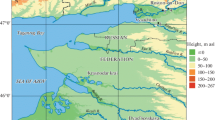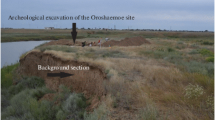Abstract
Diagnostic features of a catastrophic aridization of climate, desertification, and paleoecological crisis in steppes of the Lower Volga region have been identified on the basis of data on the morphological, chemical, and microbiological properties of paleosols under archeological monuments (burial mounds) of the Middle Bronze Age. These processes resulted in a certain convergence of the soil cover with transformation of zonal chestnut (Kastanozems) paleosols and paleosolonetzes (Solonetz Humic) into specific chestnut-like eroded saline calcareous paleosols analogous to the modern brown desert-steppe soils (Calcisols Haplic) that predominated in this region 4300–3800 years ago.1 In the second millennium BC, humidization of the climate led to the divergence of the soil cover with secondary formation of the complexes of chestnut soils and solonetzes. This paleoecological crisis had a significant effect on the economy of the tribes in the Late Catacomb and Post-Catacomb time stipulating their higher mobility and transition to the nomadic cattle breeding.
Similar content being viewed by others
References
E. V. Arinushkina, Manual on the Chemical Analysis of Soils (Moscow State University, Moscow, 1970) [in Russian].
Archeological Encyclopedia of Volgograd Oblast (Volgograd State Univ., Volgograd, 2009) [in Russian].
Atlas of Volgograd Oblast (General Department of Geodesy and Cartography, Kiev, 1993) [in Russian].
E. V. Blagodatskaya and N. D. Anan’eva, “Assessment of the resistance of soil microbial communities to pollutants,” Eurasian Soil Sci. 29, 1251–1255 (1996).
A. A. Bobrov, “Phytoliths of the steppe plants of Iki- Burul’skii district of Kalmykia: first results,” in Ostrovnoi Burial Ground: The Results of Complex Analysis of Archeological Monuments in the Northwestern Caspian Region (Moscow, 2002), pp. 167–186.
G. M. Bongard-Levin and E. A. Grantovskii, From Scythia to India. Ancient Arias: Myths and History (Nauka, Moscow, 1983) [in Russian].
A. V. Borisov, T. S. Demkina, and V. A. Demkin, Paleosols and Climate of Yergeni in the Bronze Age (4th–2nd Centuries BC) (Nauka, Moscow, 2006) [in Russian].
A. V. Borisov, R. A. Mimokhod, and V. A. Demkin, “Paleosols and nature conditions of southern Russian steppe in the Post-Catacomb period,” Kratkie Soobshch. Inst. Arkheol., Ross. Akad. Nauk, No. 225, 144–154 (2011).
I. B. Vasil’ev, O. F. Kuznetsov, and M. A. Turetskii, “Yamnaya and Poltavkin cultures,” in The History of Samara Volga Region from Ancient Time until Present. The Bronze Age (Samara, 2000), pp. 6–64.
A. V. Vinogradov and E. D. Mamedov, Primitive Lyavlyakan (Nauka, Moscow, 1975) [in Russian].
N. P. Gerasimenko, “Environmental changes in the steppe zone of Ukraine during Middle and Late Bronze Age,” Proceedings of the V International Conf. “Evolution of the Soil Cover” (Pushchino, 2009), pp. 187–189.
E. V. Glushko, “Historical and geographical analysis of the landscapes of Western Iraq using satellite images,” Izv. Vses. Geogr. O-va 122 (3), 255–262 (1990).
A. A. Gol’eva, “Interaction of a man and nature in the northwestern Caspian region in the Bronze Age,” in Seasonal Economic Cycle of the Population of the Northwestern Caspian Region in the Bronze Age, Tr. Gos. Istor. Muz., (Moscow, 2000), No. 120, pp. 10–29.
V. A. Demkin, Paleosol Science and Archeology: Integration in the Study of History and Society (Pushchino Scientific Center, Russian Academy of Sciences, Pushchino, 1997) [in Russian].
V. A. Demkin, A. V. Borisov, T. S. Demkina, et al., Volga-Don Steppe in the Ancient and Medieval Times (According to Soil and Archeological Studies) (Synchrobook, Pushchino, 2010) [in Russian].
V. A. Demkin, A. V. Borisov, and S. N. Udal’tsov, “Paleosols and climate in the southeast of the Central Russian Upland during the Middle and Late Bronze ages (the 25th–15th Centuries BC),” Eurasian Soil Sci. 43, 5–14 (2010).
V. A. Demkin, T. S. Demkina, A. O. Alekseev, et al., Paleosols and Climate of the Steppes of Lower Volga Region in 1st–4th Centuries BC (Pushchino Scientific Center, Russian Academy of Sciences, Pushchino, 2009) [in Russian].
V. A. Demkin, T. S. Demkina, M. A. Borisova, and N. I. Shishlina, “Paleosols and paleoenvironment of the southern Ergeni Upland in the end of the fourth and in the third millennia BC,” Eurasian Soil Sci. 35, 571–578 (2002).
V. A. Demkin, M. V. El’tsov, A. O. Alekseev, T. V. Alekseeva, T. S. Demkina, and A. V. Borisov, “Soil development in the Lower Volga area during the historical period,” Eurasian Soil Sci. 37, 1324–1333 (2004).
V. A. Demkin, B. N. Zolotareva, T. S. Demkina, T. E. Khomutova, N. N. Kashirskaya, M. V. El’tsov, and S. N. Udal’tsov, “Dynamics of the properties of steppe paleosols of the Sarmatian time (2nd century BC–4th century AD) in relation to secular variations in climatic humidity,” Eurasian Soil Sci. 45, 119–131 (2012).
V. A. Demkin, N. N. Kashirskaya, T. S. Demkina, T. E. Khomutova, M. V. El’tsov, “Paleosol studies of burial mounds in the Ilovlya River valley (the Privolzhskaya Upland),” Eurasian Soil Sci. 41, 115–127 (2008).
V. A. Demkin, A. S. Yakimov, A. O. Alekseev, N. N. Kashirskaya, and M. V. El’tsov, “Paleosol and paleoenvironmental conditions in the Lower Volga steppes during the Golden Horde period (13th–14th centuries AD),” Eurasian Soil Sci. 39, 115–126 (2006).
T. S. Demkina, A. V. Borisov, and V. A. Demkin, “Microbial communities in the paleosols of archaeological monuments in the desert-steppe zone,” Eurasian Soil Sci. 33, 978–986 (2000).
T. S. Demkina, A. V. Borisov, and V. A. Demkin, “Microbiological study of paleosols buried under Kurgans in the desert-steppe zone of the Volga–Don interfluve,” Eurasian Soil Sci. 37, 743–748 (2004).
T. S. Demkina, T. E. Khomutova, A. V. Borisov, and V. A. Demkin, “Microbiological study of paleosols bur under kurgans in the valley of the Ilovlya River,” in Archeological Data on Volga-Don Steppes (Volgograd State Univ., Volgograd, 2004), No. 2, pp. 87–95.
T. S. Demkina, T. E. Khomutova, N. N. Kashirskaya, I. V. Stretovich, and V. A. Demkin, “Microbiological investigations of paleosols of archeological monuments in the steppe zone,” Eurasian Soil Sci. 43, 194–201 (2010).
T. G. Dobrovol’skaya, L. V. Lysak, G. M. Zenova, and D. G. Zvyagintsev, “Analysis of soil bacterial diversity: methods, potentiality, and prospects,” Microbiology (Moscow) 70, 119–132 (2001).
D. G. Zvyagintsev, I. V. Aseeva, I. P. Bab’eva, and T. G. Mirchink, Practical Manual on Soil Microbiology and Biochemistry (Moscow State University, Moscow, 1980) [in Russian].
I. V. Ivanov, Soil Evolution of the Steppe Zone in the Holocene (Nauka, Moscow, 1992) [in Russian].
N. N. Kashirskaya, T. E. Khomutova, T. S. Demkina, and V. A. Demkin, “The microbial biomass in paleosols buried under kurgans and in recent soils in the steppe zone of the Lower Volga region,” Eurasian Soil Sci. 42, 536–542 (2009).
N. N. Kashirskaya, T. E. Khomutova, V. V. Dmitriev, V. I. Duda, N. E. Suzina, and V. A. Demkin, “The morphology of cells and the biomass of microorganisms in the buried paleosols and modern steppe soils of the Lower Volga region,” Eurasian Soil Sci. 43, 1140–1149 (2010).
A. V. Kiyashko, Origin of Catacomb Culture in the Lower Volga Region (Volgograd, 1999) [in Russian].
K. V. Kremenetskii, “Nature of the Holocene in the Lower Don and Kalmykia,” in Steppe and Caucasus, Tr. Gos. Istor. Muz. (Moscow, 1997), No. 97, pp. 30–45.
R. A. Mimokhod, “Lolinskaya culture. Northwestern Caspian region at the turn of the Middle and Late Bronze Ages,” in Materials of Protected Archeological Researches (Moscow, 2013), Vol. 16.
R. A. Mimokhod, “Radiocarbon chronology of the block of post-Catacomb cultural formations,” Kratkie Soobshch. Inst. Arkheol., Ross. Akad. Nauk, No. 225, 28–53 (2011).
L. N. Plekhanova, V. A. Demkin, “Paleosols of kurgans of the Early Iron Age in the Transural steppe zone,” Eurasian Soil Sci. 41, 1–12 (2008).
L. N. Plekhanova, V. A. Demkin, and G. B. Zdanovich, Soil Evolution in the River Valleys of Steppe Trans-Ural Region in the Second Half of the Holocene (Nauka, Moscow, 2007) [in Russian].
Ya. G. Ryskov and V. A. Demkin, Development of Soils and Environment of the Steppes of Southern Urals in the Holocene (Pushchino Scientific Center, Russian Academy of Sciences, Pushchino, 1997) [in Russian].
E. Z. Tepper, Microorganisms of Genus Nocardia and Humus Decomposition (Nauka, Moscow, 1976) [in Russian].
V. A. Trifonov, “Corrections to the absolute chronology of culture of the Eneolith-Bronze of North Caucasus,” in Between Europe and Asia. Caucasus in 4th–1st Centuries Years BC (St. Petersburg, 1996), pp. 121–130.
T. E. Khomutova and V. A. Demkin, “Assessment of the microbial biomass using the content of phospholipids in soils of the dry steppe,” Eurasian Soil Sci. 44, 686–692 (2011).
T. E. Khomutova, T. S. Demkina, and V. A. Demkin, “Estimation of the total and active microbial biomasses in buried subkurgan paleosoils of different age,” Microbiology (Moscow) 73, 196–201 (2004).
T. E. Khomutova, N. N. Kashirskaya, and V. A. Demkin, “Assessment of the living and total biomass of microbial communities in the background chestnut soil and in the paleosols under burial mounds,” Eurasian Soil Sci. 44, 1373–1380 (2011).
N. I. Shishlina, “Potential seasonal economic cycle of the carriers of Catacomb cultures in northwestern Caspian region,” in Seasonal Economic Cycle of the Population in the Northwestern Caspian Region in the Bronze Age, Tr. Gos. Istor. Muz. (Moscow, 2000), No. 120, pp. 54–71.
N. I. Shishlina, Northwestern Caspian Region in the Bronze Age (4th–3rd Centuries BC), Tr. Gos. Istor. Muz. (Moscow, 2007), No. 165.
A. S. Yakimov, V. A. Demkin, and A. O. Alekseev, Natural Conditions of the Steppes of Lower Volga Region in the Medieval Age (8th–14th Centuries BC) (NIAPriroda, Moscow, 2007) [in Russian].
J. P. E. Anderson and K. H. Domsch, “A physiological method for the quantitative measurement of microbial biomass in soils,” Soil Biol. Biochem. 10 (3), 215–221 (1978).
T. S. Demkina, T. E. Khomutova, N. N. Kashirskaya, E. V. Demkina, I. V. Stretovich, G. I. El-Registan, and V. A. Demkin, “Age and activation of microbial communities in soils under burial mounds and in recent surface soils of steppe zone,” Eurasian Soil Sci. 41, 1439–1447 (2008).
COHORT Software, V. 4.21, 1986, (Berkely, CA, 1990).
T. E. Khomutova, T. S. Demkina, A. V. Borisov, et al., “An assessment of changes in properties of steppe kurgan paleosols in relation to prevailing climates over recent millennia,” Quat. Res. 67 (3), 328–336 (2007).
J. M. Tiedje, S. Asuming-Brempong, K. Nuesslein, et al., “Opening the black box of microbial diversity,” Appl. Soil Ecol. 13, 109–122 (1999).
T. J. Weiss, and M.-A. Courty, “The genesis and collapse of third millennium North Mesopotamia civilization,” Science 261, 995–1004 (1993).
Author information
Authors and Affiliations
Corresponding author
Additional information
Original Russian Text © T.S. Demkina, A.V. Borisov, V.A. Demkin, T.E. Khomutova, T.V. Kuznetsova, M.V. El’tsov, S.N. Udal’tsov, 2017, published in Pochvovedenie, 2017, No. 7, pp. 799–813.
Deceased.
Rights and permissions
About this article
Cite this article
Demkina, T.S., Borisov, A.V., Demkin, V.A. et al. Paleoecological crisis in the steppes of the Lower Volga region in the Middle of the Bronze Age (III–II centuries BC). Eurasian Soil Sc. 50, 791–804 (2017). https://doi.org/10.1134/S1064229317070018
Received:
Published:
Issue Date:
DOI: https://doi.org/10.1134/S1064229317070018




